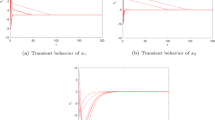Abstract
A projected-based neural network method for second-order cone programming is proposed. The second-order cone programming is transformed into an equivalent projection equation. The projection on the second-order cone is simple and costs less computation time. We prove that the proposed neural network is stable in the sense of Lyapunov and converges to an exact solution of the second-order cone programming problem. The simulation experiments show our method is an efficient method for second-order cone programming problems.






Similar content being viewed by others
References
Lebret H, Boyd S (1997) Antenna array pattern synthesis via convex optimization. IEEE Trans Signal Process 45:526–532
Lu WS, Hinamoto T (2003) Optimal design of IIR digital filters with robust stability using conic-quadratic-programming updates. IEEE Trans Signal Process 51:1581–1592
Luo ZQ (2003) Applications of convex optimization in signal processing and digital communication. Math Program 97B:1581–1592
Alizadeh F, Goldfarb D (2003) Second-order cone programming. Math Program 95:3–51
Kuo Y, Mittelmann Hans D. Interior point methods for second-order cone programming and OR applications. Comput Optim Appl, 28, 255-285 (2004)
Chen XD, Sun D, Sun J (2003) Complementarity functions and numerical experiments for second-order cone complementarity problems. Comput Optim Appls 25:39–56
Fukushima M, Luo ZQ, Tseng P (2002) Smoothing functions for second-order cone complementarity problems. SIAM J Optim 12:436–460
Chen JS, Tseng P (2005) An unconstrained smooth minimization reformulation of the second-order cone complementarity problems. Math Progr 104:293–327
Kanzow C, Ferenczi I, Fukushima M (2009) On the local convergence of semismooth Newton methods for linear and nonlinear second-order cone programs without strict complementarity. SIAM J Optim 20:297–320
Tank D, Hopfield J (1986) Simple neural optimization networks: an A/D converter, signal decision circuit, and a linear programming circuit. IEEE Trans. Circuits Syst, CAS-33, 533C541
Kennedy M, Chua L (1988) Neural networks for nonlinear programming. IEEE Trans Circuits Syst 35(5):554–562
Hu X, Wang J (2007) Design of general projection neural networks for solving monotone linear variational inequalities and linear and quadratic optimization problems. IEEE Trans Syst Man Cybern 37(5):1414–1421
He BS, Yang H (2000) A neural-network model for monotone linear asymmetric variational Inequalities. IEEE Trans Neural Netw 11(1):3–16
Gao X, Liao L, Qi L (2003) A neural network for monotone variational inequalities with linear constraints. Phys Lett A 307:118–128
Gao X, Liao L (2009) A new projection-based neural network for constrained variational inequalities. IEEE Trans Neural Netw 20:373–388
Chen JS, Ko CH, Pan SH (2010) A neural network based on the generalized FischerCBurmeister function for nonlinear complementarity problems. Inform Sci 180:697–711
Ko CH, Chen JS, Yang CY (2011) Recurrent neural networks for solving second-order cone programs. Neurocomputing 74:3646–3653
Liu DR, Wang D, Yang X (2013) An iterative adaptive dynamic programming algorithm for optimal control of unknown discrete-time nonlinear systems with constrained inputs. Inform Sci 220:331–342
Chen H, Ni D, Qin J, Li S, Yang X, Wang T, Heng PA (2015) Standard plane localization in fetal ultrasound via domain transferred deep neural networks. IEEE J Biomed Health Inform 19:1627–1636
Wang X Z (2015) Uncertainty in learning from big data-editorial. J Intell Fuzzy Syst 28:2329-2330
Lu SX, Wang XZ, Zhang GQ, Zhou X (2015) Effective algorithms of the Moore-Penrose inverse matrices for extreme learning machine. Intell Data Anal 19:743C760
He YL, Wang XZ, Huang JZX (2016) Fuzzy nonlinear regression analysis using a random weight network. Inf Sci. doi:10.1016/j.ins.2016.01.037 (in press)
Ashfaq RAR, Wang XZ, Huang JZX, Abbas H, He YL Fuzziness based semi-supervised learning approach for intrusion detection system (IDS). Inform Sci. doi:10.1016/j.ins.2016.04.019 (in press)
Benson HY, Vanderbei RJ (2003) Solving problems with semidefinite and related constraints using interior-point methods for nonlinear programming. Math Program 95(B):279-302
Outrata JV, Sun D (2008) On the coderivative of the projection operator onto the second-order cone. Set-Valued Var Anal 16: 999-1014
Kong L, Tuncel L, Xiu N (2009) Clarke generalized jacobian of the projection onto symmetric cones. Set-Valued Var Anal 17:135–151
Lobo MS, Vandenberghe L, Boyd S, Lebret H (1998) Application of second order cone programming. Linear Algebra Appl 284:193–228
Luenberger DG (1973) Introduction to linear and Nolinear programming. Addison-wesley, MA
He BS (1994) Solving a class of linear projection equations. Numerische Mathematik 68:7l–80
He BS (1994) A new method for a class linear variational inequalities. Math Program 66:137–144
Slotine J-JE, Li W (1991) Applied nonlinear control. Prentice-Hall, Englewood Cliffs, NJ
Smith TE, Friesz TL, Bernstein DH, Suo ZG (1997) In: Ferris MC, Pang JS (eds) Complementarity and variational problems. State of Art, SIAM, Philadelphia
Leung Y, Chen KZ, Jiao YC et al (2001) A new gradient-based neural network for solving linear and quadratic programming problems. IEEE Trans Neural Netws 12:1074–1083
Ghaoui LEI, Lebret H (1997) Robust solutions to least-squares problems with uncertain data. SIAM J Matrix Anal Appl 18:1035–1064
Sturm JF (1999) Using SeDuMi 1.02, a MATLAB toolbox for optimization over symmetric cones. Optim Methods Softw 11–12:625–653
Author information
Authors and Affiliations
Corresponding author
Additional information
This work was supported by the National Science Foundations for Young Scientists of China (11101320, 61201297), National Science Basic Research Plan in ShaanXi Province of China (Program No. 2015JM1031), and the Fundamental Research Funds for the Central Universities (JB150713).
Rights and permissions
About this article
Cite this article
Zhang, Y. A projected-based neural network method for second-order cone programming. Int. J. Mach. Learn. & Cyber. 8, 1907–1914 (2017). https://doi.org/10.1007/s13042-016-0569-0
Received:
Accepted:
Published:
Issue Date:
DOI: https://doi.org/10.1007/s13042-016-0569-0




